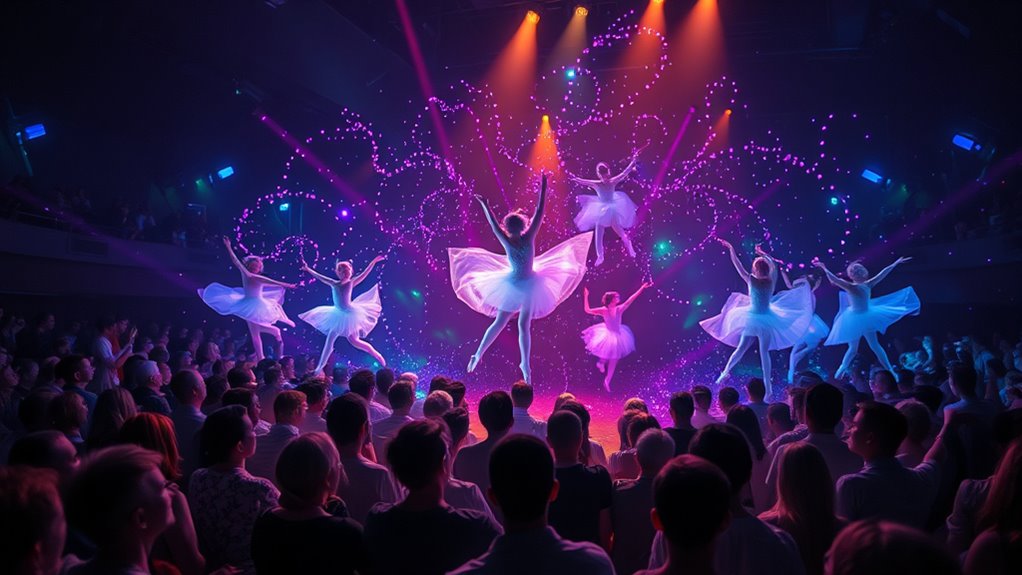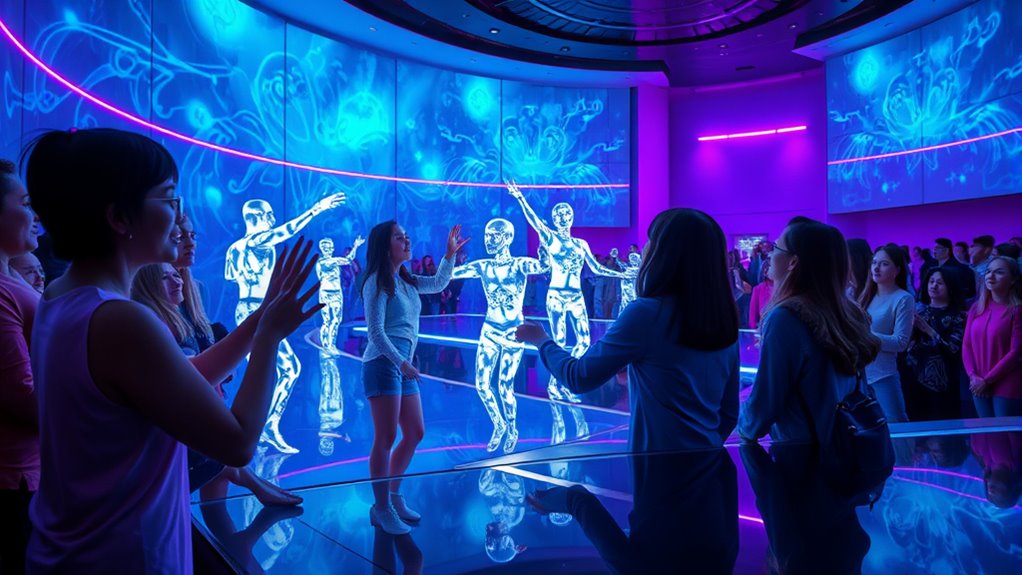Interactive holographic theaters are changing the way you experience performances. You’ll find yourself actively participating in storytelling, influencing the plot as characters interact with you. This blend of augmented reality and live action surrounds you with immersive environments, making it feel like you’re stepping into another world. Each show is unique, shaped by your choices and gestures. It’s an evolution in entertainment that fosters deeper connections and heightened engagement. Discover how this technology continues to transform the art of storytelling.
Key Takeaways
- Interactive holographic theaters merge digital content with live performances, transforming traditional storytelling into dynamic experiences.
- Audience engagement is heightened as viewers influence the storyline, fostering a deeper emotional connection with the performance.
- The immersive experience allows characters to interact with viewers, creating a sense of stepping into a different reality.
- These theaters encourage artistic experimentation, pushing creative boundaries across various genres like action and drama.
- The future of entertainment shifts from passive consumption to active co-creation, appealing to modern audiences’ shrinking attention spans.

As technology advances, you may find yourself stepping into a domain where entertainment merges seamlessly with interactivity in the form of holographic theaters. Imagine walking into a venue where the stage is alive with three-dimensional images, creating a mesmerizing spectacle that pulls you into the story. This isn’t just a cinematic experience; it’s a dynamic interaction that breaks the barriers between the audience and the performance. Holographic theaters utilize augmented reality to enhance your viewing experience, engaging you in ways traditional performances can’t.
Step into a world where holographic theaters transform storytelling into an interactive spectacle, merging reality with captivating three-dimensional images.
In these innovative spaces, you’re not merely a spectator; you become part of the narrative. The combination of stunning visuals and real-time interactivity means that your choices can influence the storyline. With each decision you make, the performance adapts, giving you a unique experience that’s different every time you attend. This level of audience engagement transforms passive watching into active participation, creating a deeper emotional connection to the narrative.
Imagine a scene where characters acknowledge your presence, or where you can manipulate elements of the performance with simple gestures. The technology behind holographic theaters allows for this kind of interaction, making you feel as if you’re stepping into a different reality. Augmented reality plays an essential role here, layering digital content onto the live performance, blending the real and virtual worlds. You’ll find yourself surrounded by characters and scenes that interact with you directly, enhancing your immersion in the story.
The potential applications of holographic theaters are vast. Whether it’s a thrilling action sequence or a poignant drama, the ability to engage the audience actively can redefine how stories are told. You’ll see artists experimenting with this technology, pushing the boundaries of creativity and performance art. As a result, each show becomes a collaborative experience, where your responses shape the unfolding drama.
In a world where attention spans are shrinking, interactive holographic theaters offer a solution. They capture your interest, stimulating your senses and imagination in ways that traditional media struggles to achieve. In this new sphere of entertainment, you’re not just watching a story; you’re living it. This fusion of augmented reality and audience engagement prepares you for a future where entertainment is not only consumed but also co-created, promising an exhilarating evolution in how we experience performance. Studies show effective time management can boost productivity by up to 25%, a principle that may also be applied in the scheduling of interactive performances to maximize audience engagement.
Frequently Asked Questions
How Much Does It Cost to Attend a Holographic Theater Performance?
Attending a holographic theater performance typically costs between $20 and $100 per ticket, depending on the venue and the show. You’ll find ticket pricing varies based on seat location and demand. When you’re ready to go, you can easily purchase tickets online or at the box office. Just remember to check for any special discounts or promotions, as those can save you some money while enhancing your immersive experience!
Are There Age Restrictions for Holographic Theater Audiences?
Typically, there aren’t strict age restrictions for holographic theater audiences, but some performances might have recommended age limits due to content. Remarkably, about 60% of attendees are under 30, showcasing its appeal to younger generations. Accessibility considerations are essential, ensuring everyone can enjoy the experience. Always check specific event guidelines, as they can vary, and you wouldn’t want to miss out on an innovative performance just because of age-related policies!
Can I Participate in the Performance as an Audience Member?
Yes, you can participate in the performance as an audience member! Many holographic theater experiences encourage audience interaction, allowing you to engage directly with the storyline and characters. You might find yourself making choices that influence the narrative or even stepping into the action. With personal participation becoming a key aspect, you’ll feel more connected to the performance, making it an unforgettable experience where you’re not just a spectator, but part of the show!
What Technology Is Required to Experience Holographic Performances at Home?
To experience holographic performances at home, you’ll need augmented reality devices, like smart glasses or VR headsets, that transport you into a digital domain. Think of it as stepping into a modern-day version of Plato’s cave, where shadows become vibrant realities. You’ll also want a high-speed internet connection and compatible software to guarantee sensory immersion. With these tools, you’ll open a world where art and technology blend seamlessly, creating unforgettable experiences.
How Do Holographic Theaters Impact Traditional Live Performances?
Holographic theaters transform traditional live performances by enhancing audience engagement through augmented reality. You’ll find that these immersive experiences draw you in like never before, allowing for unique interactions with performers and the storyline. While traditional performances focus on physical presence, holographic shows create a dynamic blend of reality and virtual elements, mesmerizing your attention in new ways. This shift encourages artists to explore innovative storytelling methods, reshaping the future of performance art.
Conclusion
As you step into the future of immersive performance, imagine this: by 2025, the global holographic display market is projected to reach a staggering $3.4 billion. Interactive holographic theaters are set to revolutionize how you experience storytelling, blending the physical and digital worlds in ways you’ve only dreamed of. With the ability to engage audiences like never before, these theaters will redefine entertainment, making every performance a truly unforgettable adventure. Get ready; the future is just around the corner!










